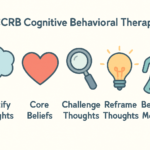By Psychologist Arjuun Sahay
CBT isn’t some fancy, untouchable thing. It’s like having a toolkit for your brain which is sometimes messy, sometimes surprising, but always practical. That’s where ICCRB comes in. It’s a simple method I created and you can use to wrestle with those tangled thoughts and feelings without going into the loops of overthinking.
ICCRB stands for Identify the thoughts, Core beliefs, Challenge thoughts, Reframe the thoughts, and Behaviour modification. Think of it like taking your mind to the gym, only without the sweatbands or complicated machines.
Identify the Thoughts
Your mind tosses thoughts around like popcorn in a hot pan some nice and fluffy, some burnt, some salty, and others just plain weird. The trick? Pause. Pin down the one thought that’s buzzing the loudest.
Example: After a session, I might have a thought, “I totally messed up that.”
Then I notice the emotions those thoughts bring up. Feel it Embarrassment at 60 out of 100, frustration maybe around 80.
Note the scene Room smells of chai, session just ended.
Treat this as a snapshot. No editing. No judgment. Just noticing what’s really zooming around your head.
Core Beliefs
Underneath those quick thoughts live the big, old stories like the ancient wallpaper stuck on your mind’s walls. Sometimes they came from childhood, sometimes from the parents who raised you, and sometimes they’re your own creation from years of experience.
For example, that thought “I messed up” might be tied to the belief “I have to be perfect to be accepted.”
Look out for patterns. Does that story pop up only in tough sessions or almost every time you doubt yourself?
These beliefs might be messy, tangled like yarn a cat played with. And that’s perfectly okay. The goal is to notice what’s there.
Challenge the Thoughts
Now, you can become a curious detective, not a harsh judge.
Gather evidence for the thought: “The client looked bored. I stumbled on a question.”
Gather evidence against: “But the client also thanked me. We addressed their real issue.”
Catch any thinking traps like all or nothing thinking, mind reading, or fortune telling that make your brain spin soap opera style dramas.
Ask yourself: Would I speak this way to a friend? Probably not. Be kinder to yourself than that.
Reframe the Thoughts
No glitter or fake pep talk here. Reframing means telling the truth with kindness.
Old thought: “I failed and everyone noticed.”
New thought: “I made some mistakes but also did some things well. That was today.”
Notice the emotional shift. That roaring storm of anxiety becomes background noise, like distant traffic instead of a thunderclap.
If your reframe sounds like a cheesy poster, ditch it. Say what you actually believe.
Behaviour Modification
Thoughts and behaviors are like dance partners. Change one and the other follows.
Try small tests: write quick notes for your next session, ask a colleague for feedback, check in with your client if they found the session helpful.
Small changes build confidence way better than trying to overhaul everything overnight.
Think of it like switching your coffee to oat milk tiny swap, big effect over time.
Putting ICCRB into Action: A Real-Life Example
You get an email: “Supervision meeting tomorrow.” The heart starts with the gymnastics.
Identify: Thought “I will look foolish.” Anxiety 80.
Core belief: “If I’m not competent, people will stop respecting me.”
Challenge: For I’m nervous, it’s a tough crowd. Against I’ve survived harder days.
Reframe: “It’s okay to feel nervous. Showing up and trying counts more than being perfect.”
Behaviour: Write a quick outline. Practice what I want to say. Eat a solid breakfast so I’m not jittery.
When the meeting starts, the nerves are there but manageable a breeze, not a cyclone.
- Write your thoughts down on whatever you can find, even napkins.
- Say your reframe out loud, even if your only audience is the houseplant.
- Give your inner critic a funny name. Mine’s Captain Catastrophe.
- Track your wins like scoring points in a casual game celebrate the small stuff.
- Eat well, get decent sleep, and move a little. Your brain runs smoother with fuel and fresh air.
The ICCRB Cheat Sheet
- I: What’s the thought? How intense is it?
- C: What old belief is hiding behind this thought?
- C: What’s the evidence for and against? Any thinking traps?
- R: What’s a kinder, truer way to think about this?
- B: What’s one small thing I can try to see if it helps?
This isn’t magic. It’s your mind’s compass. Use ICCRB as your guide through storms and sunshine alike. Stumble a bit. Laugh a lot. Keep going one thought and one step at a time. And if nothing else, remember there is always metaphorical cake waiting somewhere.
You got this.

